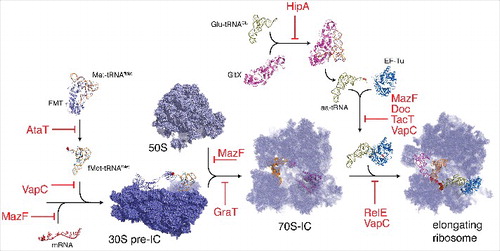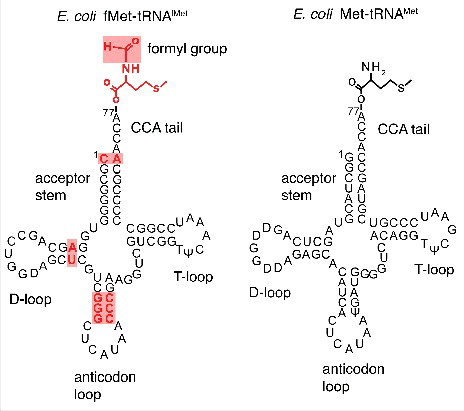Figures & data
Figure 1. Type II TA toxins inhibit nearly every step of translation. Toxins blocking different steps of translation process are indicated in red, translation machinery components and assembly units are labeled in black. AtaT toxin acetylates Met-tRNAfMet and generates translation-incompatible acetylated Met-tRNAfMet that is not recognized by initiation factor IF2.Citation1 TacT acetylates elongation tRNAs on their amino acid blocking the free amine group necessary for peptide bond formation.Citation31 Different VapC toxins cleave either the anticodon loop of initiator tRNACitation22,25, the sarcin-ricin loop of 23S rRNACitation24 or different elongator tRNAs.Citation23 Different MazF toxin cleave either mRNAsCitation17, elongator tRNAsCitation19 or 23S rRNA.Citation18 RelE toxins cleave mRNAs that are being translated.Citation40 GraT inhibits ribosome biogenesis.Citation41 Doc phosphorylates elongation factor EF-Tu.Citation20 HipA phosphorylates Glutamyl-tRNA-synthetase.Citation42,43

Figure 2. Initiator fMet-tRNAfMet and elongator Met-tRNAMet. The secondary structure of tRNAs is represented in cloverleaf fashion highlighting the major sequence differences important for initiator tRNA identity during translation.

Figure 3. AtaT toxicity is not reversed by Pth overexpression. The ataT gene was cloned in the pBAD33 plasmid under the pBAD promoter control. The ataR and pth genes were cloned in the pKK223-3 plasmid under the pTac promoter control as previously described1. Overnight cultures of E. coli strain (DJ624Δara, a MG1655 derivative devoid of the ataT-ataR system) carrying combination of pBAD33 derivatives and pKK223-3 derivatives as indicated on the left panel were serially diluted as indicated above the panel and spotted on LB agar plates supplemented with 0.2% arabinose and 1 mM IPTG (left panel). After incubating the plates overnight at 37°C, colonies from the 10-3 dilution were collected and streaked on LB agar with 1% glucose to test viability (right panel).

